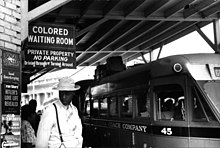Freedom Riders
![]()
This article describes the movement in the USA. For the movement in Australia inspired by it, see Freedom Ride (Australia).
Freedom Ride is the name of a form of resistance that grew out of the civil rights movement in the United States. The so-called Freedom Riders participated in the abolition of state-sanctioned racial segregation by riding intercity buses into the southern states to test and, if necessary, sue for the implementation of the Supreme Court's decision (364 U. S. 454 1960) banning racial segregation in public transportation, restaurants, and waiting rooms.
The first Freedom Ride left Washington, D.C. for New Orleans on May 4, 1961. The ride was intended to check the status quo and whether local practices complied with the law, with a view to filing suit if necessary. The joint ride by whites and blacks provoked violent protests, gave momentum to the civil rights movement, and brought the issue to the attention of first American citizens and later the entire world. Some of the participants were arrested for trespassing, unlawful assembly, and violating state and local laws.
The Freedom Riders had committed themselves to nonviolent resistance before the ride, but were aware that they might be subject to arrest and rioting. Between June and September 1961, about sixty more rides took place.
The action received little support from leading political figures; since President John F. Kennedy depended on the votes of Southern congressmen for his foreign policy program, he avoided actively addressing the issue of civil rights. In connection with the "Freedom Riders," Kennedy told civil rights attorney Harris Wofford, "Can't you stop your goddamn friends from getting on those buses? Tell them to call it off. Tell them that!"

"At the bus station." Photo, Jack Delano, May 1940
The first ride
On May 4, 1961, seven black and six white passengers left Washington DC on Greyhound and Trailways buses. The tactic was to have mixed seating, with at least one black in the front section reserved for whites. With minor difficulties, the buses traveled through Virginia, North Carolina, and Georgia.
Outside Anniston, Alabama on May 14, the buses were attacked by a mob and one bus was set on fire. The mob tried to hold the doors shut to let the occupants burn alive. However, when the vehicle's fuel tank exploded, the passengers escaped from the bus but were attacked again. Only warning shots fired by a Highway Patrol trooper prevented the lynching. Freedom Riders later admitted to the local hospital were shown the door by hospital staff at 2 a.m. because of fears of mob attacks. Cars procured by Pastor Fred Shuttlesworth were used to transport the injured to safety.
When the Trailways buses reached Birmingham, Alabama, they were attacked by members of the Ku Klux Klan. Under orders and with the assistance of police commissioner Bull Connor, the Freedom Riders were brutally beaten with baseball bats, iron bars, and bicycle chains. The white participants in particular were segregated and beaten.
Since the bus drivers refused to continue the journey and also other transports of the Freedom Riders out of fear, the remaining participants wanted to fly to New Orleans. After bomb threats and attacks in the airport this succeeded.
Onward journey of the students
Ten students attempted to continue the Freedom Ride and drove to Birmingham on May 17, 1961, where they were arrested by Bull Connor. Two days later, more Freedom Riders headed toward Montgomery, Alabama, under attack from the Ku Klux Klan. The Highway Patrol, present under pressure from the U.S. government, left the convoy at the edge of town, and again the participants were mercilessly attacked. Again, the police present allowed the rioting to continue.
When Pastor Ralph Abernathy's First Baptist Church, occupied by 1,500 sympathizers, was attacked on the night of May 21, where Martin Luther King, Jr. was giving a speech, Governor John Malcolm Patterson deployed the National Guard. The Kennedy administration had threatened to send in federal troops.
After reaching Montgomery on May 22, the Freedom Riders continued toward Mississippi on May 24. The federal government and the governors of Alabama and Mississippi agreed that the National Guard and state police should protect the ride, but that the federal government would not intervene if participants were arrested for violating segregation laws. Those arrests, however, would have violated federal law. Upon arrival in Jackson, the participants, including William Sloane Coffin, were arrested as they attempted to enter the bus depot.
Some sixty Freedom Rides took place between June and September 1961, with over three hundred arrests in Jackson alone.
Search within the encyclopedia